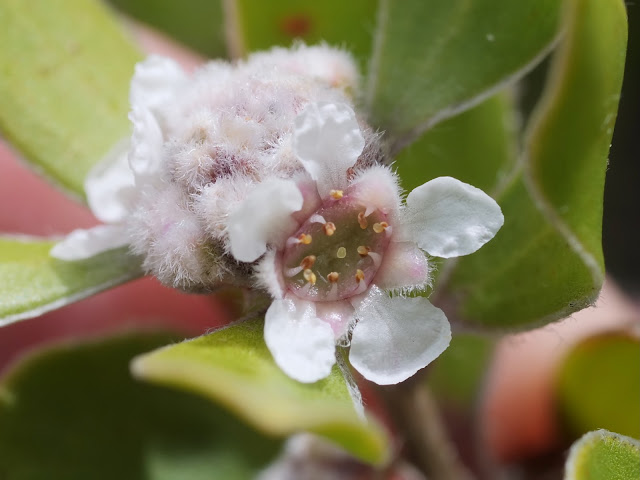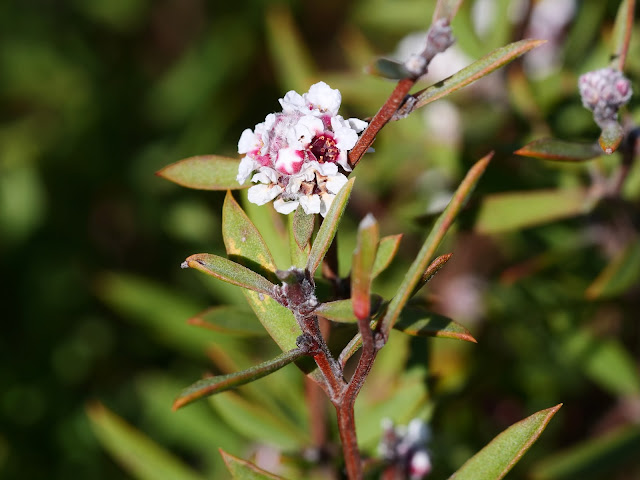Taxandria
There are eleven species of Taxandria all endemic to the south-west of Western Australia. One species, conspicua, is divided into two subspecies. They are usually shrubs but two species, T. parviceps and T. linearifolia grow into very small trees and T. juniperina can grow into quite a large tree (over 20 m tall). Flowers are in heads, generally globular.
The most noticeable feature of the flowers, which may require a magnifying glass (or phone magnifying app) to see, is there are ten stamens, one opposite each petal and sepal. The use of the word opposite confused me when I was first looking at this genus and to the non-botanist could perhaps be better described as 'next to' as there is one stamen by each petal and sepal. The name taxandria is derived from the Latin tax - ordered and andrus - male and refers to this orderly stamen arrangement.
The fruit, like the flower heads, are in clusters, generally globular, each fruit having three valves.
A distribution map for each species is shown below together with some brief notes. The species pages have more information and photos.
Taxandria angustifolia
Very narrow, thick leaves up to 23 mm long. Found in a limited number of locations over a small range. Flowers late summer to autumn, petals persisting long after that.
Taxandria callistachys
Narrow, thick leaves up to 25 mm long. Found mainly east of Esperance but may occur in Ravenswood area. Flowers late autumn to early spring with petals persisting months after that.
Taxandria conspicua ssp. conspicua
Found only around granite outcrops, usually further inland than T. marginata. Leaves up to 25 mm long, narrower than T. marginata. Flowers most likely autumn and winter.
Taxandria conspicua ssp. abrupta
Unlike ssp. conspicua found away from granite out crops. With leaves up to 15 mm long and 5 mm wide easily distinguished from other species where it is found (except possibly in Cape Arid where T. marginata may be found). Flowers mainly winter and spring but may also flower in autumn.
Taxandria floribunda
Leaves up to 15 mm long and 4.5 mm wide. Most easily identified by the persistent bracts which suround the flower heads and fruits. Flowers mainly in October. Note distribution may be more extensive than shown in the map below.
Taxandria fragrans
A swamp species. Leaves up to 11 mm long and 2 mm wide, spreading and rigid. Flowers late summer to winter, petals persist long after that.
Taxandria inundata
Prefers swamps which remain flooded longer than the areas T. fragrans grows. Leaves up to 14 mm long and 6 mm wide and usually recurved. Flowers late summer to winter, petals persting months after that.
Taxandria juniperina
Leaves up to 13 mm long and 1.5 mm wide, soft not rigid (quite unlike T. frangrans). Found on edges of swamps and watercourses. Can grow into a tree up to 27 m tall - much taller than any other Taxandria species. Flowers autumn to early winter.
Taxandria linearifolia
Leaves up to 45 mm long and 4 mm wide, flat and quite thin. Often weeping habit. Found by swamps and watercourses. Flowers mainly spring to early summer.
Taxandria marginata
Found only around granite outcrops. Leaves up to 28 mm long and 10 mm wide with a marging of white appressed (lying flat) hairs. Flowers autumn and winter.
Taxandria parviceps
Leaves up to 7 mm long and 1.5 mm wide, thick usually clustered on short ancillary shoots. Flowers mainly in late winter and spring but petals persist until autumn.
Taxandria spathulata
Leaves up to 6 mm long and 5 mm wide - really quite small, spathulate (spoon shaped) but often appear round. Flowers in spring.
All photographs (c) Keith Morris, some rights reserved (CC BY-NC) unless otherwise indicated.
















Comments
Post a Comment